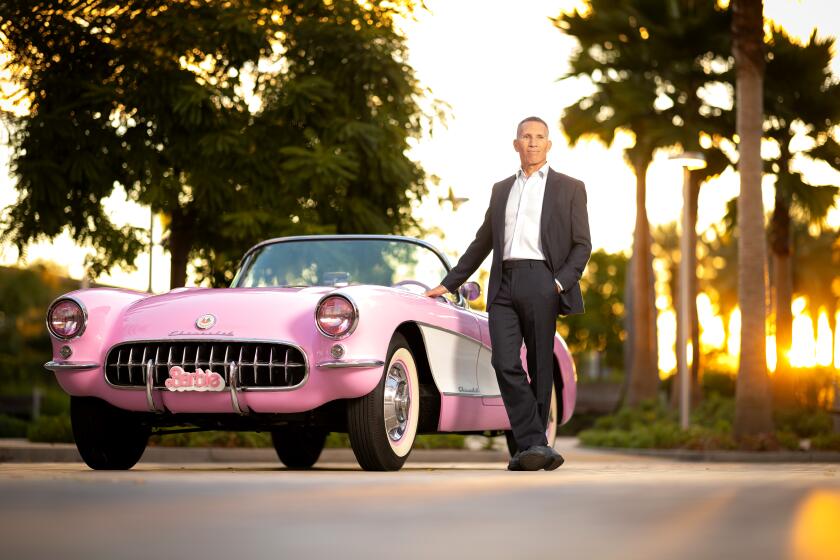COLUMN ONE : THE FUTURE : City Office, Home on the Range : Technology now allows urban professionals to live a time zone or more away from work. Rural towns fear they’re becoming fiber-optic suburbs.
With the mountain sun filtering through cottonwood trees and chamisa bushes, businessman and writer Christopher Leinberger rises at dawn, walks the dogs, feeds the chickens, puts his five horses out to pasture and heads for his office on Wilshire Boulevard--more than 1,000 miles away.
Flying in from Albuquerque, Leinberger spends two days a week in Los Angeles running his real estate consulting firm. Other days he is what many city dwellers dream of being--the embodiment of a recent ad for AT&T; picturing a fellow in blue jeans, sitting on a wooden deck overlooking a mountain meadow, reading, writing or researching in the privacy of his own high-country retreat.
Leinberger and others like him, including business executives, doctors, television producers and writers, are the privileged progeny of a high-tech age that is making it possible for people to have the best of both worlds--a job in the city and a home on the range, or in the mountains, 1,000 miles or more from the office.
For most business and professional people, days or weeks away from the office are made possible by personal computers, sophisticated phone systems and, most of all, the facsimile machine with its ability to transmit signed documents within seconds across the country or around the world.
“Buy a fax and live in paradise,” joked Don Bachman of the Greater Yellowstone Coalition, a Montana-based environmental organization that is watching the new trend in Western living with some trepidation.
If it is a liberating experience for ex-urbanites, the impact of the computer culture on rural enclaves throughout the West is another matter. From Santa Fe, N.M., to Telluride, Colo., to Driggs, Ida., gated estates are beginning to replace ranch houses and old adobes. Country stores are stocking pate and California wine, new residents are demanding better schools and better services. Prices are soaring, and all of this is leading natives to wonder if their little towns are destined to become high-end suburbs of some distant metropolis.
Census figures provide evidence of the trend. Counties surrounding Park City, Utah; Vail, Colo.; Santa Fe and other popular destinations are growing nearly twice as fast as the states they are in.
“What we are seeing is the birth of the national/international bedroom community,” said Miles Rademan, public affairs director for Park City. “Instead of working in Chicago and living in Lake Forest, people are working in New York or San Francisco and living in a small town in the mountains.”
Despite the difficulty of traveling great distances twice a week, long-distance commuters speak almost rapturously about their new lives.
“Life here is more relaxed, less competitive and more creative. It helps nurture feelings of trust and support. . . . I know I’m speaking in cliches, but they’re true,” said Patti Wilson, a corporate personnel consultant who moved from Minneapolis to Santa Fe four years ago.
The 1970s also saw a migration of city folk to the country. But that was a relatively simpler time, characterized by disillusioned urbanites eager to abandon whole the fast lane and all of its perquisites.
“People don’t want to get away from it all anymore,” said Richard Lowenberg, an architect who is building a home in Telluride while he commutes monthly to an office in Sonoma County. “They want to bring it with them, the culture, the food, the amenities of city life. But they want to enjoy it in a place that is safe, healthy and scenic.”
Nor would many of the long-distance commuters give up the gratification of a big-city career, even if they could make do in the small towns where they prefer to live.
“I’m not about to give up the career I’ve built in L.A.,” said Sherri Abend-Fels, a psychologist who practices four days a week in Los Angeles and lives three days a week in a cozy adobe house on the edge of the Santa Fe National Forest.
Although some places look for ways to tax the newcomers or limit their numbers, at least one community is trying to make them more comfortable by planning a new town designed especially for the high-tech commuter.
In tiny Telluride, with a full-time population of 1,200, town planners are laying the groundwork for a sort of Space Age suburb known as “Mesa Z” that is expected to be twice the size of the existing town. In Mesa Z, the communications needs of the computer commuter--or the “information independent” as they are known locally--will be as accessible as the nearest wall socket.
“A fiber-optic network, a regional microwave system and a satellite up-down link will be the components of a sophisticated information utility at Mesa Z,” Lowenberg said. “It may sound far out, but we think of it (the information utility) as like the sewer system of the future.”
For Los Angeles-based commuters, Santa Fe and its environs, including Tesuque, is becoming one of the most popular places to live.
Regular travelers speak of the first-class section on certain flights from Albuquerque to Los Angeles as if it were a little neighborhood, made up almost entirely of long-distance commuters who share the joys and stresses of splitting their weeks between Santa Fe and Los Angeles.
“There’s sort of a syndrome we joke about,” psychologist Abend-Fels said. “Sunday night you get the blues. We call it the dismals around here. Monday morning, you’re sad. Then on the plane you switch gears and, by the time you land, you’re ready to go to work.”
A recent study of the Santa Fe housing market by Chris Leinberger’s real estate consulting firm showed that last year 75% of home purchases over $200,000 were made by Southern Californians. The study also found that up to 47% of all out-of-state buyers were long-distance commuters.
With its exotic blend of cultures--Latino, Indian and Anglo--its adobe buildings and richly varied landscape, Santa Fe has traditionally been home to a colony of expatriates, many of them wealthy. So have several other Old West towns from Arizona to Montana.
But longtime residents say that the people coming these days are a different breed.
“In the old days, Santa Fe was a refuge for the black sheep of the family. They came from the East Coast. They had money or access to it. But they mixed easily with the Hispanics in a live-and-let-live sort of way. The mixture led to a high-style/barrio-style fabric that not everybody is comfortable with today,” said architect John T. Midyette III, who grew up in Santa Fe.
“Some of the people who come here today are frustrated by what they see as a lackadaisical attitude. They can’t get used to a culture where the guy who is pouring the concrete for your brand-new house takes off deer hunting without telling you,” Midyette said.
In northern New Mexico, where a mixture of great beauty and extreme poverty create a rural, Third World flavor, newcomers are not immune from a mild culture shock. They grouse about dirt roads, mud huts and stick fences, arguing that, for all their quaintness, they are symbols of a backwardness that ultimately is bad for the region and its people.
“I’m not into this rustic-is-better attitude. I think the culture in some ways perpetuates the cycle of poverty,” said Joshua Freilich, who has been commuting for two years between the optical supply company he runs in North Hollywood and his new home in Santa Fe.
If Western commuters share one thing in common besides a desire to escape to the mountains, it is financial independence. Most are successful entrepreneurs, sole practitioners or well-paid performers, writers and artists whose schedules allow for long absences from the big city.
Jack Theimer, a Tulsa real estate developer who lived for a while in Vail and now makes his home in Montecito, estimated the average income of long-distance commuters he knows at $250,000 a year.
“A lot of times you can’t charge off all the air fare to your business. It isn’t fair to your business partners. When I first started going back and forth I paid for it out of my own pocket. The first year alone ran to $60,000 or $70,000,” Theimer said.
There are the costs of doing business long distance from home--$1,000-a-month telephone bills or the expense of transmitting several hundred documents via fax machine each week. Many commuters maintain two homes. The city residence may be a pied - a - terre over the office or something more suitable for entertaining clients.
Out in the hinterlands, the implications of the new wealth are raising some hackles. In the mountain West, where much of the land is controlled by government, building sites have always been scarce. It doesn’t take long for high-end demand to drive real estate prices out of reach of local pocketbooks.
Moreover, some of the new houses--immense turreted affairs reminiscent of Beverly Hills--are regarded locally as obscene monuments to unobtainable wealth.
In Aspen, Colo., where this sort of thing has been going on for many years, a local land planner talked about a 50,000-square-foot mansion being built for a Saudi prince and joked that “it’s becoming a case of the unconscionably rich driving out the filthy rich.”
To the north, in Idaho’s Teton Valley, a potato farmer named Boyd Bowles is leading a campaign to stop developers from building their planned Alpine village, a community that would more than double the size of the nearest town, Driggs.
“They’re talking about an ‘ I-talian ‘ village on the ridge top right smack in the way of our views,” Bowles said. “The least they should do is have it blend in with the Western flavor around here.”
With no planning or zoning laws on the books, Bowles said, local officials do not have the tools to properly regulate such a large development.
Moreover, Bowles echoed an oft-heard complaint in Western towns--that an onslaught of upper-crust commuters will price ordinary folks off the ski slopes and ultimately off the land they have farmed for generations.
In Santa Fe, local politics is beginning to ring with the rhetoric of us-versus-them.
“A lot of people--long-timers--are being forced to leave this town. It’s getting to the point where we are selling out our culture,” said Debbie Jaramillo, a city councilwoman and candidate for mayor.
Jaramillo proposes a stiff tax on real estate transactions of $200,000 or higher as a way of making wealthy newcomers pay more for city services and of discouraging a wholesale transfer of land that has been held for centuries by local families.
However, the councilwoman faces a dilemma shared by many Western towns that have low property tax rates. Raising taxes may be a way to meet the increased demand for services, but the approach runs the risk of antagonizing old-timers, who see their property as a potential gold mine.
Some of the newcomers are aware of the disruptive impact they can have.
“As an Anglo and an outsider, you have to realize it is in your power to break up the fabric of life here,” said Chris Leinberger’s wife, Matty.
Like a number of the new residents, Matty Leinberger has become a participant in community life. She teaches a math class and started a free breakfast program at a nearby elementary school, where many of the children come from a rural barrio.
Miles Rademan, Park City’s public affairs director, said the newcomers should be welcomed, not just for their money but for their ideas.
“These are sophisticated, cultured people with a certain amount of energy and savvy to offer. We have to start to entice them into the community,” he said.
Listening to newcomers describe their initial experiences, however, it appears that in some places the cold shoulder is proffered as often as the warm handshake.
“The locals can be downright chilly when they want to. The hostility often is unspoken, but you can read it in people’s body language,” said a real estate consultant who lives in Idaho’s Teton Valley while still maintaining an office in Boston.
The hostility can get physical.
The Leinbergers’ son, a fourth-grader, was roughed up on one of his first days of school in Tesuque.
“The whole class jumped him. He definitely did not win that encounter,” his mother said.
With the passing of time and the aid of karate lessons, young Leinberger has made his peace, and his parents now joke about what happened to him. But like many former city dwellers who are ambitious for their children, the Leinbergers worry about schooling in a community where it is normal for many students not to go on to college.
“Education is going to be a problem,” Matty Leinberger said.
But, with all of those anxieties, most of the new commuters insist that they are not about to go back to life in the city.
“In L.A., you are what you drive,” said Freilich, who owned a Jaguar before he moved to Santa Fe. “Here, you are known for who you are and how you act towards your neighbors.”
Freilich spends most days beside his fax machine immersed in the contracts, purchase orders, patents and product analyses that are transmitted to him from his North Hollywood office.
By being so far away, he admitted, he gives up some control over day-to-day operations, but so far, he said, he doesn’t mind the sacrifice.
“It’s the little things that make life worthwhile,” Freilich said. “Like the trip to the market that turns into an hour and a half because you keep running into people, and you’re standing and chatting and it’s not idle chatter. You find yourself talking about the town and what’s happening here and what you can do to make a difference.”
Of all the new commuters, few know more about the way of life than Leinberger. He has written about urban migration patterns for national magazines, and his company has studied these trends in the process of advising businesses on where to expand their operations.
The next step in the suburbanization of the Mountain West, Leinberger said, will come when executives who move to rural New Mexico or Idaho bring their companies with them.
One firm has already set the precedent. Eight years ago, Debbi Fields of Mrs. Fields Cookies moved her corporate headquarters from the San Francisco Bay Area to Park City, a town Fields had fallen in love with on a skiing trip. Today, relying on computers, telephones and fax machines, Fields said she and 130 employees comfortably direct the operations of 650 franchises worldwide.
“We thought if we had a wonderful place in the mountains, talented people would gladly come and work for us, and we were right,” Fields said.
These days, Leinberger said, he is beginning to make fewer trips out of New Mexico as more clients choose to come to him. He has opened a small office in downtown Santa Fe.
Watching the budding of this latest trend, Leinberger said he doubts that towns such as Santa Fe, 60 miles from the nearest major airport, will become corporate hubs. But he said it is possible that the town could lose some of the country charm that attracted him there, and he joked about his role in changing the place.
“I have met the enemy and it is me,” he said.






